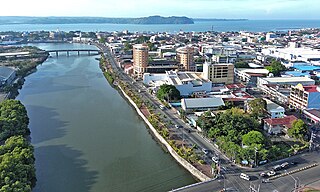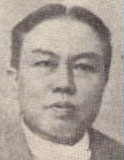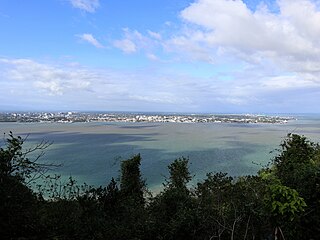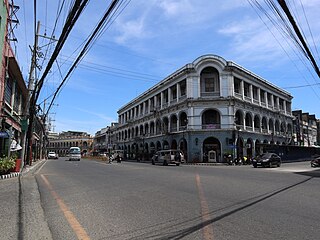
Iloilo, also called Iloilo Province, officially the Province of Iloilo, is a province in the Philippines located in the Western Visayas region. Its capital and largest city is Iloilo City, the regional center of Western Visayas and politically independent from the province. Iloilo occupies the southeast portion of the Visayan island of Panay and is bordered by the province of Antique to the west, Capiz to the north, the Jintotolo Channel to the northeast, the Guimaras Strait to the east, and the Iloilo Strait and Panay Gulf to the southwest.

Western Visayas is an administrative region in the Philippines, numerically designated as Region VI. The region comprises the islands of Panay and Guimaras. It consists of five provinces: Aklan, Antique, Capiz, and Iloilo on Panay, and the island province of Guimaras. The region also includes one highly urbanized city, Iloilo City, which is the largest city and serves as the regional center.

Roxas, officially the City of Roxas, is a 3rd class component city and capital of the province of Capiz, Philippines. According to the 2020 census, it has a population of 179,292 people, making it the most populous city in Capiz and also the second-most populous city in Western Visayas, after Iloilo City.

Iloilo City, officially the City of Iloilo, is a 1st class highly urbanized city in the Western Visayas region of the Philippines, located on the southeastern coast of the island of Panay. According to the 2020 census, Iloilo City has a population of 457,626 people, making it the most populous city in Western Visayas. For the metropolitan area, the total population is 1,007,945 people.
The Hiligaynon people, often referred to as Ilonggo people or Panayan people, are the second largest subgroup of the larger Visayan ethnic group, whose primary language is Hiligaynon, an Austronesian language of the Visayan branch native to Panay, Guimaras, and Negros. They originated in the province of Iloilo, on the island of Panay, in the region of Western Visayas. Over the years, inter-migrations and intra-migrations have contributed to the diaspora of the Hiligaynon to different parts of the Philippines. Today, the Hiligaynon, apart from the province of Iloilo, also form the majority in the provinces of Guimaras, Negros Occidental, Capiz, South Cotabato, Sultan Kudarat, and North Cotabato.

The Iloilo River is an estuary river located in the province of Iloilo, in Western Visayas, Philippines. The river starts in Oton at the Batiano estuary, then traverses through the Iloilo City districts of Arevalo, Molo, Mandurriao, La Paz, Lapuz, and the City Proper, before emptying into the Iloilo Strait.

Iloilo City Proper, also known as Downtown Iloilo or simply Iloilo among locals, is an administrative district in Iloilo City, Philippines, located on the southeastern coast of the island of Panay in the Western Visayas region. It serves as the civic center of the city and province of Iloilo, hosting the seat of city and provincial governments, as well as various local, provincial, and regional government offices. According to the 2020 census, it has a population of 46,350 people.

Metropolitan Iloilo–Guimaras, also shortened as Metro Iloilo–Guimaras or Metro Iloilo, or simply MIG, is a metropolitan area in Western Visayas in the Philippines. It is situated on the southeastern coast of Panay, including the nearby island province of Guimaras, surrounded by the Iloilo and Guimaras straits.

The Port of Iloilo is a seaport located in Iloilo City, Philippines. It serves the city, province of Iloilo, and the entire island of Panay in the Western Visayas region of the Philippines. It is located in the districts of Iloilo City Proper and Lapuz, on the southeastern coast of Panay, in Iloilo Strait, and one of the country’s safest and most natural harbors. The Port of Iloilo is managed by the Philippine Ports Authority, a government-owned corporation, and consists of major facilities: the Iloilo River Wharf, Iloilo Domestic Port, and the Visayas Container Terminal.

Antonio Ledesma Jayme was a Filipino lawyer, revolutionary hero, Governor of Negros Occidental, and assemblyman, as well as a lawmaker and a revolutionary nation's founding father and a signatory to a nation-state's constitution.

The John B. Lacson Foundation Maritime University is a private maritime institution based in Molo, Iloilo City, Philippines. It is the first maritime school in the Visayas and Mindanao, first private maritime education and training institution in the Philippines, and the first maritime institution in the country to obtain the accreditation of DNV.

Metro Bacolod is the 8th-most populous and the 6th-most densely populated metropolitan area out of the 12 metropolitan areas in the Philippines. This metropolitan area as defined by the National Economic and Development Authority (NEDA) has an estimated population of 840,170 inhabitants as of the 2020 official census by the Philippine Statistics Authority.
Nicholas Loney was an English businessman and the British Empire's vice-consul in the city of Iloílo.

The Iloilo Strait is a strait in the Philippines that separates the islands of Panay and Guimaras in the Visayas, and connects Panay Gulf with the Guimaras Strait. It is the location of the Port of Iloilo, the third-busiest of the ports in the Philippines in number of ships. Iloilo City on Panay is the major city located on the strait with Buenavista and Jordan, both on Guimaras, immediately across the strait from the city. The Iloilo River empties into the strait.

The Batangas International Port or locally known as the Batangas Pier is a seaport in Barangay Santa Clara, Batangas City primarily serving the Calabarzon region of the Philippines. The seaport covers an area of about 150 hectares.

Panay Railways, Inc. is a government-owned and controlled corporation of the Philippines that formerly operated railway systems on the islands of Panay and Cebu. It is headquartered in La Paz, Iloilo City, and is a subsidiary of Phividec Railways, Inc. under the Philippine Veterans Investment Development Corporation (PHIVIDEC). While Panay Railways currently does not operate any trains, it leases its property, and the generated revenue is utilized to cover personnel and administrative costs associated with maintaining its assets.

Calle Real, officially named as J.M. Basa Street, is a historic street located in the old downtown district of Iloilo City Proper in Iloilo City, Philippines. It is home to several fine examples of luxury American-era neoclassical, beaux-arts, and art deco buildings. The street has been famous since the Spanish era and once served as the city's main shopping center for more than a century.

The Iloilo Customs House is a historical building in Iloilo City, Philippines. It was built in 1916 to a design by American architect Ralph Harrington Doane, then Consulting Architect of the Bureau of Public Works in the Philippine Islands. Among the three American-era customs houses in the Philippines, it is the second largest and second oldest. The building is located at Muelle Loney Street and Aduana Street along the Iloilo River and still houses the offices of the Bureau of Customs and the Bureau of Immigration in Iloilo City.

The Casa Real de Iloilo, also known as the Old Iloilo Provincial Capitol, was the seat of the provincial government of Iloilo in the Philippines since the Spanish colonial period until 2006. It also served as the residence of the alcalde-mayor, presidente municipal, or governor, who held the highest authority as the Spanish official in Iloilo during the period.

The Iloilo Freedom Grandstand, also known as the New Iloilo Freedom Grandstand, is a grandstand located on Muelle Loney Street in Iloilo City Proper, Iloilo City, Philippines. It was built in 2018 as a replacement for the old grandstand with the same name located on Calle Real, which was demolished the same year as part of the revival project of Sunburst Park, where the grandstand used to be located.





















